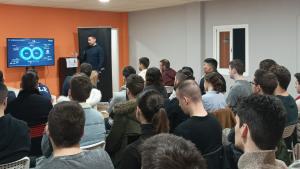Mainframe Systems Transformation: Devops and the agility organizations need - Asset Display Page

Mainframe Systems Transformation: Devops and the agility organizations need

Mainframe Systems Transformation: Devops and the agility organizations need
srpna 02, 2024
Despite the exponential growth of cloud computing, mainframe systems remain crucial in the infrastructure of many organizations. However, their development cycles have not evolved, posing challenges in moving towards a more modern, agile, and flexible environment.
Mainframe systems celebrated their sixtieth anniversary last April. For over half a century, they have been the backbone of technological applications in organizations worldwide, especially in Europe and the United States. According to an IBM study, 45 of the top 50 banks, four of the top five airlines, seven of the top ten global retailers, and 67 Fortune 100 companies rely on these robust and secure systems.
Beyond volume and scale, mainframe-based applications are often the most critical in any organization. In fact, 71% of executives in the study identified them as fundamental to their business strategy, underscoring the mainframe's role as the cornerstone of technological infrastructure, justifying the high investment in these systems.
The study also shows that 93% of companies use mainframes for financial management, and 73% use them for customer transaction systems. This high adoption rate demonstrates organizations' trust in their unmatched robustness, security, and capacity to process large data volumes, with origins dating back to 1944.
However, not everything is advantageous in the mainframe world. COBOL remains the primary development language, limiting organizational agility and flexibility and hindering new talent attraction, making companies less competitive.
CLOUD, MAINFRAME...
The cloud has become synonymous with innovation and agility, growing exponentially as organizations adapt to new technologies and operational needs. Given this, many might consider mainframes relics of the past. While cloud environments offer numerous benefits, such as scalability, flexibility, and reduced operational costs, these savings are not as apparent for mainframes. Furthermore, fully converting mainframe applications to more modern languages is challenging, despite the advent of AI-based tools.
DevOps Offers Quick Benefits with Reduced Costs and Time
These strategies entail significant risks that few organizations dare to face, especially concerning their most critical applications. Thus, far from being obsolete, mainframe systems are undergoing a transformation, placing them at the heart of companies' digital strategies. The challenge lies in finding the right balance to achieve desired efficiency without losing the unique strengths of these systems, achievable only by modernizing their development cycles.
THE REINVENTION OF THE MAINFRAME
In this context, our proposal is to lead the transformation of mainframe systems through DevOps strategies. We implement new development models based on continuous integration/continuous deployment (CI/CD) pipelines in mainframe environments, leveraging each organization's current tech stack. This increases productivity—estimated at over 25% with mainframe modernization—while minimizing the cultural shift associated with new tools.
This strategy helps organizations accelerate modernization and efficiency plans, maximizing their investments in mainframe infrastructure. Additionally, it leverages tools often included in their IBM enterprise license agreements (ELA).
Adopting DevOps strategies in mainframe systems also addresses a growing concern: attracting new talent. By integrating new code editors with more modern development interfaces like Visual Studio Code or IBM Developer for z/OS, and using open-source tools like Jenkins or Git, we create a dynamic and attractive environment that enhances developer experience and attracts new talent.
In summary, we assist organizations with core business operations on mainframe systems, recognizing that while these systems are at the tech forefront, their development processes are inefficient and manual. Thus, not transforming them is no longer an option. It is imperative to focus efforts on their evolution rather than their elimination.
NEORIS ZDEVOPS
At NEORIS, we have developed our own suite of solutions, zDevOps, comprising various extensions for Visual Studio Code that significantly improve developer experience and mainframe interaction:
- File Editor: Allows viewing and editing of sequential files (QSAM) generated on IBM Z systems.
- Scheduler Viewer: Visualizes the scheduling of batch processes running in the production environment.
- COBOL Lint: Analyzes COBOL code quality rules in real-time.
- BMS Designer: Enables graphical and dynamic creation of CICS program screens or BMS maps.
- Software Control Management: Connects to IBM SCLM to manage the software development lifecycle in a single environment, enhancing productivity and experience.
In conclusion, transforming mainframe systems is a challenge organizations must proactively address to remain competitive in today’s market. Partnering with an experienced ally can accelerate success, allowing companies to make the most of their mainframe systems while advancing towards a more modern and agile infrastructure that enables adaptation and growth in a constantly changing business environment.
Featured
-
EPAM Anuncia Acuerdo para Adquirir NEORIS
září 4, 2024
-
Cómo Salesforce Manufacturing Cloud resuelve los retos actuales de previsión de la demanda
srpna 27, 2024
-
Transformación de los sistemas mainframe: Devops y la agilidad que necesitan las organizaciones
srpna 2, 2024
-
NEORIS y GitHub unen fuerzas para revolucionar el desarrollo de software
července 11, 2024
Most viewed
-
NEORIS lanza HealthCheck para ayudar a las empresas frente al Coronavirus
března 27, 2020
-
IA, SIM Swap y disrupción: las tendencias más destacadas del MWC 2024
března 25, 2024
-
NEORIS se convierte en Socio del Año de Microsoft
července 23, 2020
-
Microsoft reconoce a NEORIS como socio del año para SAP en AZURE
července 23, 2020










.jpg/3dac568c-106c-3b5e-9ede-6614dc00b5d6?imageThumbnail=1)
